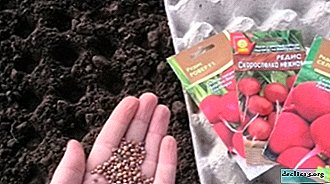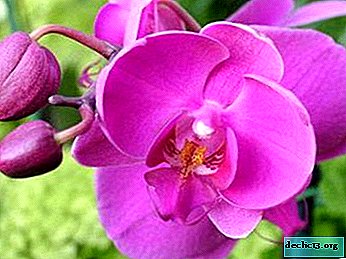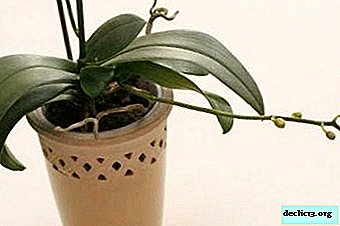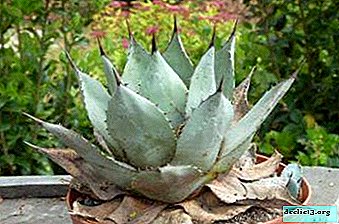Spathiphyllum plant organs: a detailed review, photo
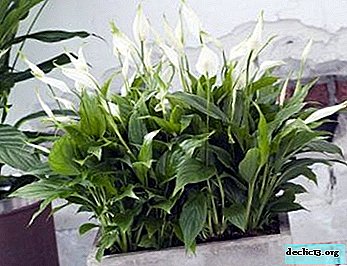
Spathiphyllum is a houseplant from the aroid family. Its name comes from the Greek words "spata" - a coverlet and "phylum" - a sheet.
The people of this exotica are called "female affection" due to the unusual shape of the leaf, which symbolizes purity and the feminine.
This genus has about 50 species, of which Wallis spathiphyllum is the most common in room culture.
Next, we will tell in detail about this culture: what are the leaves and flowers; features of the root system. What problems arise when growing it at home.
The main organs and their role in plant life
The aerial part of the plant consists of leaves, inflorescences and fruits on long petioles. The underground part includes the root system of the rhizome and the actual roots.
- Spathiphyllum leaves shiny, dark green, located on a long petiole and have a lanceolate or ovoid shape. On the leaf plate is a distinct venation. The size of the leaves varies from species to species and can reach from 15 to 70 centimeters.
Just below the leaf plate, the pulvinus is located - this is a thickened leaf pillow. With its help, the plant “controls” the arrangement of leaf blades: old leaves wilt, while the youngest ones look up. This creates a cascade effect.
With the help of leaves, spathiphyllum performs the basic functions that ensure the life of a plant: with leaves, it captures light, synthesizes organic substances, and evaporates water. Also in the culture are variegated forms of spathiphyllum having white strokes and strokes along the sheet. Variegated spathiphyllums are more demanding of light, and green ones can grow in bright diffused light and in partial shade.
Note! Drops of water sometimes appear on the ends of the leaves. This indicates excessive soil moisture.In this case, you need to reduce watering. Also, the appearance of droplets, the plant reacts to low atmospheric pressure.
- Shortened stalk - rhizome - is underground. On it are sleeping kidneys, from which daughter spathiphyllum rosettes subsequently grow. Vegetative propagation is carried out precisely with the help of rhizomes (you will learn about this and other methods of propagation of spathiphyllum from our article). In nature, spathiphyllum grows, forming picturesque wide curtains of green leaves.
An adult plant that has many rosettes can be divided into several parts, so that each of them has its own roots and leaves. Another rhizome serves as an organ storing nutrients.
- Roots the plant uses to fix on the surface of the substrate and absorb nutrients and water. In nature, spathiphyllum often grows in marshy areas, so the roots of the plant should always be in a wet state. In the summer, it is recommended to leave water in the pan to maintain moisture levels. In winter, it is better to reduce watering, and remove water from the pan immediately after watering.
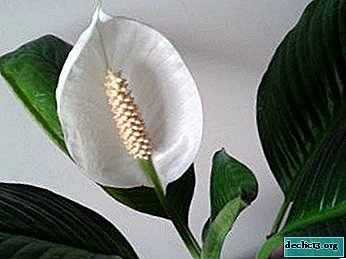 Flowers - the main organs of reproduction. An inflorescence is a cob covered with a veil, which is sometimes mistaken for a single "petal" of an inflorescence. The coverlet can have a color from white and light green to cream.
Flowers - the main organs of reproduction. An inflorescence is a cob covered with a veil, which is sometimes mistaken for a single "petal" of an inflorescence. The coverlet can have a color from white and light green to cream.The ear is light, in shape resembles an elongated cone with spikes - small flowers. At the end of flowering, the bedspread turns green. It is advisable to remove faded ears so that the plant does not spend extra strength on the ripening of the fruit. In more detail about the flowering of spathiphyllum we talked about in a separate material.
Spathiphyllum fruits - green shiny berries, formed after flowering. Inside each berry are small curved seeds. For fruit ripening, artificial pollination and greenhouse conditions are required. Seed germination is low and quickly lost.
The main functions of the fruit of spathiphyllum are the protection of seeds from damage and help in the resettlement of plants.
Important! Berries can not be used in writing! The plant is conditionally poisonous.Spathiphyllum juice contains oxalate crystals that cause irritation of the mucous membranes. When working with a plant, precautionary measures are recommended. Work with gloves on and be sure to wash your hands afterwards. We talked about whether spathiphyllum is poisonous about the benefits and dangers of a flower for humans and animals here, and from this article you will learn what to do if a cat is poisoned by the juice of a flower.
Leaf position and root system
The spathiphyllum has a leafy arrangement. The leaves are collected in a basal rosette, from the center of which young leaves and flowers appear.
The root system of spathiphyllum is fibrous, well-branched. Remember, the roots of spathiphyllum, like many aroid ones, are very fragile. When transplanting, care should be taken not to damage the root system.
Photo
In the photos offered below, you can see how the leaves, stalk, roots, flowers and other parts of spathiphyllum look like.






Possible illnesses and difficulties
- The first problem that flower growers face when growing and caring for spathiphyllum at home is the drying of the tips of the leaves. Most often this is solved by spraying, installing a humidifier or wiping the sheet plates with a damp sponge. You can also put a pot with a plant on a tray with wet expanded clay.
- If the spathiphyllum does not bloom, then the reason for this is a too spacious pot. Flowering occurs only when the roots completely braid over a lump of earth.
- Complete drying of the leaves, including young leaves, is associated with excessive watering.
- The appearance of yellowish spots indicates pests. Treat plants with mealybug and spider mite preparations.
- Rotting of the roots of the plant occurs due to too heavy soil. When planting spathiphyllum, add baking powder (perlite, expanded clay, vermiculite). Use light peat mixes to provide airflow to the roots of the plant.
- Yellowish brown spots, drying out from the middle, appear from excessive light.On a note. In summer, it is recommended to shade the plant from the midday sun.
If direct sunlight does not fall on the leaves of the spathiphyllum, the problem is excessive watering in the autumn-winter period.
More information about diseases and pests of spathiphyllum can be found here.
What are the plants that look like a flower Women's happiness?
Among representatives of the flora, close relatives are similar to spathiphyllum. These are tuberous callas - hybrids of callas of Reman and Elliot with arrow-shaped elongated leaves and multi-colored inflorescences.
Cob-shaped flowers with a veil are characteristic of all representatives of the aroid:
 allocasia;
allocasia;- dieffenbachia;
- aglaonemes;
- Anthuriums
- wingbell.
The shape of the leaf on spathiphyllum is also similar:
- Cannes;
- turmeric;
- ravalla;
- banana;
- calathea;
- aspidistra.
Leaves like Feminine happiness have gardening fungi.
Conclusion
Spathiphyllum for a reason earned great love among gardeners. Its tropical appearance and unusual-shaped flowers will decorate any home, and the low maintenance requirements, rapid growth and easy propagation only add value to the plant.
Spathiphyllum will be a good gift for lovers of exoticism and for those who are just learning the basics of plant growing.

 Flowers - the main organs of reproduction. An inflorescence is a cob covered with a veil, which is sometimes mistaken for a single "petal" of an inflorescence. The coverlet can have a color from white and light green to cream.
Flowers - the main organs of reproduction. An inflorescence is a cob covered with a veil, which is sometimes mistaken for a single "petal" of an inflorescence. The coverlet can have a color from white and light green to cream. allocasia;
allocasia;